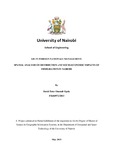| dc.description.abstract | Due to increasing globalization trends, migration has increasingly become a key element in
national and international deliberations. Mapping of immigrant issues has also gained
prominence in many parts of the world, with several agencies taking the cue. In Kenya the
management of foreigners or aliens is one of the core functions of the Department of
Immigration Services with the mandate of enhancing security and socio-economic
development through policy and management strategies targeting immigrant populations.
Currently the practice within the department, and periodic censuses have generated
immigration data, and lately emigration data, though a number of potential datasets still
remain unexploited due to inadequate use of available technology. Such sources include data
on visas and work permits, border-post data and passenger surveys at international airports
Through a review of related literature, this study showcased the great interest that other
countries have on the numbers of foreigners they host, where they live, what they do and
what sort of services they need or offer. It further demonstrated the relationship between
migration and geospatial technology and its successful application.
The study adopted a methodology involving a spatial approach in the use of location
information to enable tracking, visualizing, analyzing and management of alien activities.
This involved the geo-coding of immigrant residential addresses and linking with their
respective attributes to enable input, storage, manipulation and analysis using appropriate
spreadsheet and GIS software. The results were then presented in the form of various maps,
charts, figures and tables representing various themes according to the objectives of the
study.
In conclusion, it emerged that migration and development are related and create impact in
various perspectives and proportions. Geospatial technology is such a revolutionizing
application that has great potential for organizing, manipulating and analyzing such migration
information and can enable the department to use a variety of maps and documents to
interpret immigrant activities, including major patterns of migration; changing environmental
preferences and settlement patterns. | en_US |

